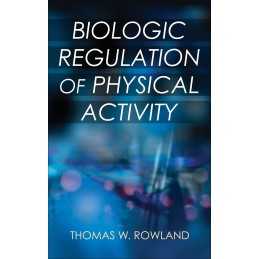- Obniżka


 Dostawa
Dostawa
Wybierz Paczkomat Inpost, Orlen Paczkę, DHL, DPD, Pocztę, email (dla ebooków). Kliknij po więcej
 Płatność
Płatność
Zapłać szybkim przelewem, kartą płatniczą lub za pobraniem. Kliknij po więcej szczegółów
 Zwroty
Zwroty
Jeżeli jesteś konsumentem możesz zwrócić towar w ciągu 14 dni*. Kliknij po więcej szczegółów
The benefits of a healthy lifestyle are well documented, yet many people continue to struggle with sedentary behavior and obesity. In Biologic Regulation of Physical Activity, Dr. Thomas W. Rowland posits a distinct possibility of the existence of a central biologic controller of activity. If harnessed, this mechanism could lead to breakthroughs in health science professionals’ quest for more effective ways of helping people be more active and, as a result, healthier.
Rowland is one of the most well-respected pediatric cardiologists in the United States. He has authored three other books and more than 150 journal articles and has served in several key national leadership positions in pediatric medicine. In Biologic Regulation of Physical Activity, Rowland uses his expertise, along with numerous references and direct quotes from expert witnesses, to provide a detailed account of how current research may support the existence of a biologic regulator—a mechanism in the brain that involuntarily controls biological processes—associated with physical activity. Rowland proposes a possible mechanism for such a control and explores the implications of this theory. This developing area of research and theory offers a new lens through which health professionals and those who research issues related to obesity, physical activity adherence, and sedentary behaviors can view their work.
The book moves methodically through the research, rationale, and implications of a biologic regulator of physical activity. In part I, Surveying the Evidence, readers are guided through a litany of research—both on humans and on animals—that provides support for the existence of a biologic regulator. This section synthesizes evidence from an interdisciplinary perspective, covering research on topics such as behavioral disorders, brain damage, lifetime activity patterns, and sex differences.
Part II, Rationale and Mechanisms details the possible biologic explanation for control of energy output through activity and proposes a mechanism by which it might function in order to maintain an energy in–energy out balance. The hypothesis presented in this section is that the body has a need for energy balance that leads to activity regulation, similar to how the body regulates appetite.
In part III, Implications of Biologic Regulation of Activity, some clear implications from current research, which may help health science professionals in their treatment and prevention efforts against patients’ obesity and inactivity, are discussed. Rowland also poses some critical questions for further research, if indeed a biologic controller of activity exists, such as how much effect a biologic controller might have on activity level as compared to environmental factors and whether this biologic regulator could be altered.
This book will initiate further discussion, examination, and research into the idea that physical activity may be, at least in part, controlled by a central biologic regulator. Further study may lead to a widespread realization that there is an involuntary biologic regulator of activity that, once fully understood, could lead researchers to discover alternative interventions in the fight against inactivity and obesity.
Opis
Part I. Surveying the Evidence
Chapter 1. Nature of Physical Activity
Measuring Physical Activity
Categorizing Physical Activity
Chapter 2. Physical Activity Through the Life Span
Human Beings
Physical Activity of Animals
Chapter 3. Effects of Sex
Sexual Maturation
Sex Differences in Infancy
Chapter 4. Neurochemical Models
Dopamine
Other Neurochemical Mediators
Chapter 5. Perturbations of Brain Function
Lesions in Animal Brains
Craniopharyngioma
Anorexia Nervosa
Restless Legs Syndrome
Attention Deficit Hyperactivity Disorder
Chapter 6. Organized Variability
Animal Circadian Rhythms
Human Circadian Rhythms
Other Variability
Chapter 7. Genetic Influences
Familial and Twin Studies
Animal Selection
Genetic Markers
Epigenetic Influences
Chapter 8. Physical Activity Play
Function of Physical Play
Neurological Basis
Part II. Rationale and Mechanisms
Chapter 9. Activity Regulation and the Need for Energy Balance
Energy Balance as a Biological Need
Role of Physical Activity in Energy Balance
Biologic Origin of Other Contributors to Energy Balance
Parallel Decline With Aging
Compensatory Responses in Energy Balance
Chapter 10. Mechanisms for Biologic Control
Feedback Systems
Proposed Biologic Control System for Habitual Physical Activity
Activity-Stat Versus Energy-Stat
Part III. Implications of Biologic Regulation of Activity
Chapter 11. Responses to Activity Interventions
Compensatory Changes in Physical Activity
Compensatory Changes in Caloric Intake
Long-Term Changes in Physical Activity Habits
Implications for Health Promotion
Chapter 12. Understanding Obesity: The Biologic Perspective
First Law of Thermodynamics
Obesity as an Error in Energy Balance
Behavioral Explanations for Energy Imbalance
Genetic Explanations for Energy Imbalance
Implications for Treatment and Prevention
Chapter 13. Altering the Biologic Control of Activity
Plasticity of Biologic Set Points
Can Cognitive Will Override Biologic Control?
Can Hedonistic Behavior Override Biologic Control?
Role of Spontaneous Physical Activity and NEAT
Pharmacological Manipulation of Physical Activity Regulators
